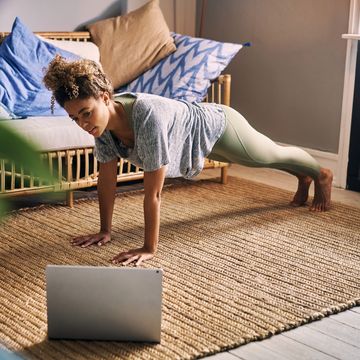Ever wonder how long you need to hold a plank to get results — without hanging out in the pose for a second longer than you need to? Us too. We’re going to get into the details (spoiler: there are a few factors to consider) but first: Here’s why you should work your core with the staple move in the first place.
Why Core Strength Is Key
According to the American Council on Exercise (ACE), the core muscles include the erector spinae (or your back extensors), internal and external obliques (responsible for rotating your trunk), obliques (these help you bend to the side), transverse abdominis (this is the muscle being used when your bootcamp instructor enthusiastically belts out “draw your belly button into your spine!”), rectus abdominis (commonly referred to as your “six-pack” muscles), and the multifidi (which keeps your spine stable).
And according to Annie Mulgrew, founding instructor for CITYROW in New York City and NASM-certified personal trainer, keeping those core muscles strong is essential to helping your body function properly.
“Core strength provides stability, as well as balance, improves overall strength, and enhances a person’s ability to do everyday tasks,” she explains. “[When your core is strong], you move better, breathe better, and function at a higher level.”
A 2019 PLOS ONE study, which focused on college-age endurance athletes, found that eight weeks of core training helped to improve runners’ endurance and balance. Meanwhile, other studies have noted that regular core strengthening was a factor in reducing chronic back pain. Mulgrew adds: “The stronger your core, the less strain on [your] lower back, knees, and shoulders.”
The Benefits Of Planks
Whether you do planks, sit-ups, crunches, or some other move really comes down to whichever form of core-strengthening you like best (or, rather, can withstand!), according to Mulgrew. Still, planks are her favorite for a single, overarching reason: You get the most bang for your buck.
“Planking is a more total-body exercise than a crunch, which focuses mostly on the rectus abdominis,” she explains. “Planking engages the arms, hips, glutes, legs, and upper back. It works those deep stabilizing muscles as it is an isometric exercise.” Sit-ups, on the other hand, engage corresponding muscles (hips, lower back) a bit more than crunches, but not as much as a plank would.
Plus, if you have a previously existing lower back or neck injury, crunches and sit-ups can cause even more damage, whereas a plank can help strengthen those muscles without causing any extra strain.
But, as Mulgrew reiterates, there is room for all types of abdominal-focused exercises. She adds that you’d compare a crunch or sit-up to a biceps curl (an isolated exercise) versus a plank to a squat or deadlift.
How To Perform A Perfect Plank
Ready to get started? Here’s how to tap into all those core-tastic strengthening and balancing benefits by executing the perfect plank:
How to: Start on the floor on your hands and knees. Place your hands directly under your shoulders. Step your feet back, one at a time. For more stability, bring your feet wider than hip-distance apart, and bring them closer for more of a challenge. Maintain a straight line from heels through the top of your head, looking down at the floor, with your gaze slightly in front of you. Now, tighten your abs, quads, glutes, and hold.
Here are some additional form tips from Mulgrew:
- Arms and legs should be perfectly extended.
- Shoulders should also be protracted, or pushed down to open up more space between your shoulder blades.
- Your tailbone reaches towards your inner heels.
- Abdominals should be fully engaged, as well as glutes and hips
How Long To Hold A Plank
The answer is not as simple as you think. Albert Matheny, R.D., C.S.C.S., co-founder of SoHo Strength Lab and advisor to Promix Nutrition, says you can plank daily, but the length of time you should hold a plank for can vary from 10 seconds to a minute. Here’s why: Your form matters most. “Keeping perfect form is the goal—only do it as long as you can keep this,” Matheny says.
As a general guideline, Doug Sklar, a certified personal trainer and founder of PhilanthroFIT in New York City, recommends striving to do three sets of up to 60 seconds. “It’s OK to start with shorter sets and work up to 60 seconds,” he says.
Plus, shorter planks can still give you a solid workout, Sklar says. He suggests holding a plank for 10 seconds, relaxing for five to 10 seconds, then re-engaging for 10 seconds, and repeating for three to six sets. “You receive very similar strengthening benefits because you are engaging your muscles for the same amount of total time as if you just held the plank for 30 to 60 seconds without stopping,” he says.
That being said, a minute tends to be an ideal time frame for getting the most from a plank. “Longer time under tension is more of a challenge,” Matheny says. But, he adds, if you can easily plank for a minute, you increase the difficulty by contracting your abs more, and squeezing your glutes and quads more.
Again, don’t push yourself to hold a plank for even longer if you’re not ready. “Forcing yourself to hold a plank for an excessive amount of time can put a lot of strain on your lower back,” Sklar says. “As fatigue sets in, the lower back may start to arch. This is where you put yourself at risk for injury.” (That’s where the 60-second reco comes into play!)
So, plank when you can and do it as long as you can hold good form, for up to a minute. You should see great results.
Take Your Plank Up A Notch
Although a plank is truly a gold-standard exercise when it comes to core strengthening and stabilizing (and perfectly fine to do as is!), you can increase the intensity of the move by adding in a few variations.
Take a peek at these 10 plank variations to try, including hand taps, elbow taps, and other destabilizing moves that’ll cause your core to work overtime to keep you in a steady position.


